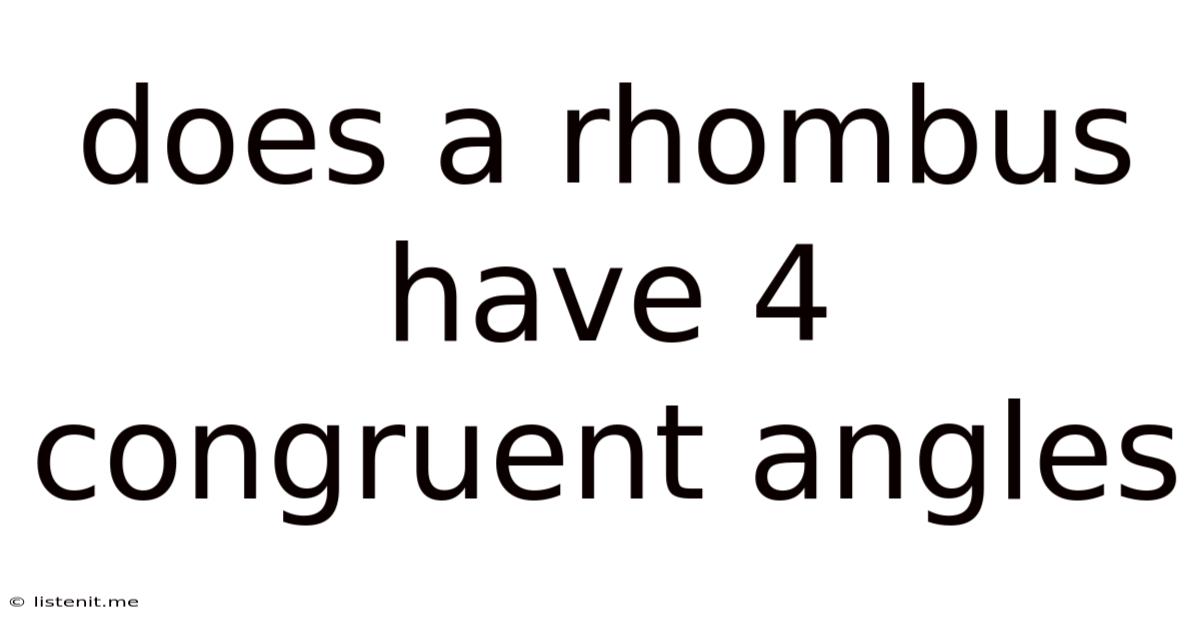Does A Rhombus Have 4 Congruent Angles
listenit
May 09, 2025 · 4 min read

Table of Contents
Does a Rhombus Have 4 Congruent Angles? Exploring the Properties of Rhombuses
The question of whether a rhombus possesses four congruent angles is a fundamental one in geometry. The answer, while seemingly simple, opens the door to a deeper understanding of the properties of rhombuses and their relationship to other quadrilaterals, such as squares and parallelograms. Let's delve into the specifics, exploring the defining characteristics of a rhombus and clarifying the crucial difference between congruent sides and congruent angles.
Understanding the Rhombus: A Definition
A rhombus, in its simplest definition, is a quadrilateral (a four-sided polygon) with all four sides being of equal length. This is the core defining characteristic that sets it apart. Think of it as a tilted square; while it shares some properties with a square, it doesn't necessarily share all of them. This distinction is key to answering our main question.
Key Properties of a Rhombus:
- Four congruent sides: This is the fundamental property. All four sides are equal in length.
- Opposite sides are parallel: Like all parallelograms, opposite sides of a rhombus run parallel to each other.
- Opposite angles are congruent: The angles opposite each other within the rhombus are equal in measure.
- Consecutive angles are supplementary: Any two angles that share a side add up to 180 degrees.
- Diagonals bisect each other: The lines connecting opposite corners (diagonals) cut each other exactly in half.
- Diagonals are perpendicular bisectors: The diagonals intersect at a right angle and bisect each other.
The Crucial Distinction: Congruent Sides vs. Congruent Angles
Here lies the heart of the matter. While a rhombus always has four congruent (equal) sides, it does not always have four congruent angles. This is the crucial point that many misunderstand. The equality of sides is the defining characteristic; the equality of angles is a consequence that only occurs under specific conditions.
Let's visualize this: Imagine a square. A square is a special type of rhombus where all angles are also congruent (90 degrees each). However, imagine now tilting the square slightly. You still have a quadrilateral with four equal sides (a rhombus), but the angles are no longer all 90 degrees. The angles opposite each other remain equal, but the adjacent angles are no longer equal. This tilted shape is still a rhombus, but it doesn't possess four congruent angles.
When Does a Rhombus Have 4 Congruent Angles?
The only time a rhombus will have four congruent angles is when it is also a square. A square is a special case of a rhombus where all angles are right angles (90 degrees). Therefore, to have four congruent angles, a rhombus needs to satisfy the additional condition of having four right angles.
Differentiating Rhombuses, Squares, Parallelograms, and Rectangles
Understanding the relationships between different quadrilaterals helps clarify the rhombus's properties.
Rhombus vs. Square:
- Rhombus: Four congruent sides, opposite angles congruent, consecutive angles supplementary.
- Square: Four congruent sides, four congruent angles (90 degrees each). A square is a special case of a rhombus.
Rhombus vs. Parallelogram:
- Rhombus: Four congruent sides.
- Parallelogram: Opposite sides congruent and parallel. A rhombus is a special case of a parallelogram.
Rhombus vs. Rectangle:
- Rhombus: Four congruent sides.
- Rectangle: Four right angles (90 degrees). A rhombus and a rectangle do not directly overlap unless the rhombus is also a square.
Exploring the Angles of a Rhombus: A Mathematical Approach
Let's explore the angles mathematically. Let's denote the angles of the rhombus as A, B, C, and D. Since opposite angles are congruent, we have A = C and B = D. Also, since consecutive angles are supplementary, we have:
- A + B = 180°
- B + C = 180°
- C + D = 180°
- D + A = 180°
If the rhombus has four congruent angles, then A = B = C = D. Substituting this into the supplementary equation, we get:
A + A = 180° => 2A = 180° => A = 90°
This proves that if a rhombus has four congruent angles, each angle must measure 90 degrees, making it a square.
Real-World Applications and Visualizations
Understanding the properties of a rhombus extends beyond theoretical geometry. Rhombuses appear in various real-world contexts:
- Crystals: Certain crystal structures exhibit rhombic shapes.
- Art and Design: Artists and designers utilize rhombuses in patterns and tessellations.
- Engineering: Rhombic structures are sometimes employed in engineering designs for their strength and stability.
By understanding the unique characteristics of a rhombus – its four congruent sides and the conditional congruence of its angles – we gain a more profound appreciation for the rich tapestry of geometric shapes and their interrelationships. The distinction between a rhombus and a square highlights the importance of precisely defining geometric figures and recognizing the specific conditions under which additional properties emerge. Remembering that a rhombus does not always have four congruent angles is crucial for accurately solving geometric problems and applying these concepts to real-world scenarios. It underlines the beauty and precision inherent in the world of geometry.
Latest Posts
Latest Posts
-
Maximum Number Of Electrons In 4f
May 09, 2025
-
H2 Pd C Reduction Of Ketone
May 09, 2025
-
What Is The Complementary Dna Strand Sequence
May 09, 2025
-
What Percentage Of 200 Is 60
May 09, 2025
-
How Many Isotopes Does Arsenic Have
May 09, 2025
Related Post
Thank you for visiting our website which covers about Does A Rhombus Have 4 Congruent Angles . We hope the information provided has been useful to you. Feel free to contact us if you have any questions or need further assistance. See you next time and don't miss to bookmark.